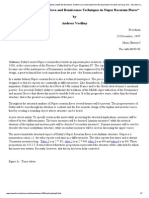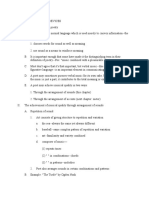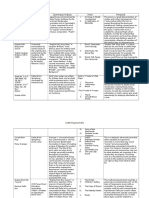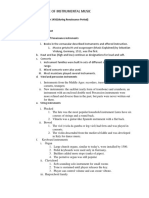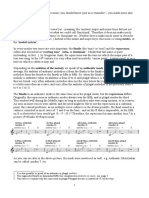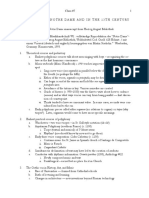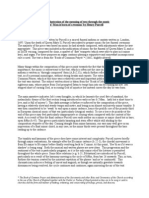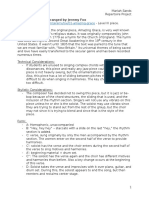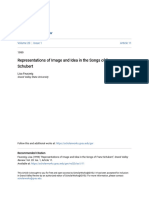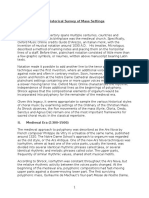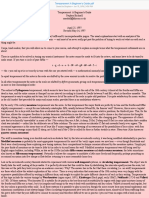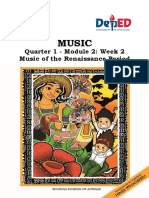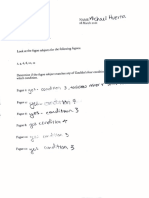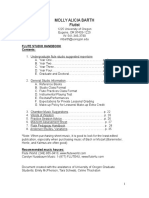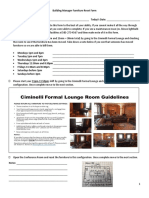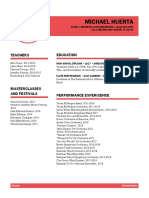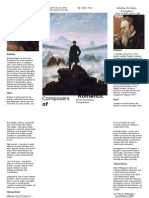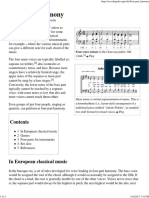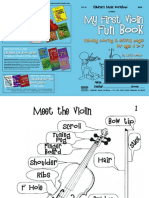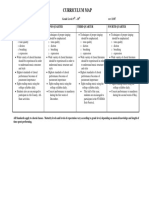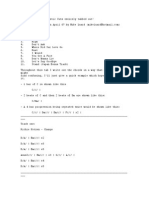Professional Documents
Culture Documents
Outline For MHS 121 Paper
Uploaded by
Michael Huerta0 ratings0% found this document useful (0 votes)
5 views3 pagesgfh
Original Title
Essay Outline
Copyright
© © All Rights Reserved
Available Formats
DOCX, PDF, TXT or read online from Scribd
Share this document
Did you find this document useful?
Is this content inappropriate?
Report this Documentgfh
Copyright:
© All Rights Reserved
Available Formats
Download as DOCX, PDF, TXT or read online from Scribd
0 ratings0% found this document useful (0 votes)
5 views3 pagesOutline For MHS 121 Paper
Uploaded by
Michael Huertagfh
Copyright:
© All Rights Reserved
Available Formats
Download as DOCX, PDF, TXT or read online from Scribd
You are on page 1of 3
Outline for MHS 121 Paper
I. Introduction and summary of Armed Man tradition
a. Secular tune that has no clear origins that turned into a phenomenon
b. Set to masses, song cycles, and changed/added onto by composers
II. Overview/Roadmap to essay and thesis
a. On Extempore II, the armed man tune is used and transformed to fit the
message of the newly composed song through the development of rhythm,
form, tonality, and texture.
III. Explanation of Bloom’s theory of poetic influence
a. Intertextuality: Changing and developing a part of the syntax or form of the
original piece while still keeping the old. Comparing the old to the new and
juxtaposing them to show them “locked in conflict”
b. Anxiety: The fear that their own work will never be as good as the original. How
do they “make room” for themselves? Makes composers push their
competitors aside
c. Misreading: When an artist tries to reinterpret a predecessors works and
misread the purpose for which they created the work. This creates room for
musical freedom and new ideas to revise and recreate the work at hand.
IV. Summary of Extempore II and description of three select works
a. Motet: “The Man, the Man”: Mixed meter; duple and triple feel, battle of
meters, perfect intervals in voices, Use of tritones, jazz sonorities and chords,
solos, improvisation
b. Gloria – “Glory Be” (Track 5): Overlapping voice texture, soloist at the
beginning, a jazz-like ostinato that includes a triplet against duple feel. Giant
Golria form.
c. Epistle – “Prayer” (Track 7): Solo sax with combo in background, Rondo form
with armed man tune as theme.
V. Transition: Why and how can Bloom’s theory be applied to music?
a. Music and Poetry are both art forms in which one build on another’s work
b. how explained in III
VI. Application of Bloom’s conceptual framework to Extempore II
a. Motet: “The Man, the Man”
i. Intertextuality: use of triple rhythms in the old version but in the new
version, the use of duple rhythms is introduced in the form of 5/8 time.
Juxaposing the old and new – mixed meter, Influence of jazz – battling
against each other? Matches aggressive armed man text.
ii. Anxiety: rewritten in a completely different tonality (G major) in stylistic
texture written four voices and Jazz Quartet which is in extremely rare
ensemble especially in the competing manner in which they perform.
More likely to be “disseminated by performance”
iii. Misreading: changed tonalities to make a major key with a festive like
feeling. When re-composing this melody, I think the arranger miss read
the context of the armed man song. The aggressive nature of the text
suggests that the melody to accompany it shouldn’t be a joyous jig like
one such as in track 1. Perfect houseplants sought to “say what they
want or need to hear.”
b. Gloria – “Glory Be” (Track 5)
i. Intertextuality: was able to preserve the form of the Gloria prayer as it
is performed in the mass ordinary. Big effort to make a difference
between quarter note triplet and half note. Changes subdivision in
beginning to duple even though in the original the entire piece was in
triple. Later in the new version, the subdivision changes to triple
incorporating both duple and triple rhythms and feel.
ii. Anxiety: honest to the style of a responsory – melismas are swapped
out for improvisation – the jazz version of a Gloria successfully re-
create something and “Clears space” by putting a modern twist on it.
Voices alternate the same passages in succession while transposing
up perfect fourth and fifths – could be extrapolating on Hocket during
the Ars nova and Renaissance time periods. In which the armed man
song was very famous
iii. Misreading: use of syncopation at bucks a, the shift between Duple
Quarter note triplets at measure 50, and the “house plant groove” all
create a sense of uneasiness because of the constant switch between
duple and triple subdivisions. This works in the jazz sections because
of the way swing style works but during the vocal lines especially at the
solo before measure 50, we feel an uneasiness as the solo ends by
changing to duple after have been in triple.
c. Epistle – “Prayer” (Track 7)
i. Intertextuality: extended the form of the armed man and added to it
create a similar form to the Rondo form. Using the first five bars of the
arms man tune as the “theme.” This extended the pieces length which
made the newer piece much more grand than the older piece. Kaizen
ideas of citation and authority and vying with the original work.
ii. Anxiety: short theme catchy tune that we’ll gain popularity. Extended
word of arms man tune. Rondo and variations on a theme are very
popular in popular music within the Canon. Has everything the original
has it even more containing impressive solos and improvisations that
will draw audiences and encourage dissemation through performance.
iii. Misreading: uses the melody at beginning of the tune but doesn’t use
the whole tune. Texted part that said “the man, the man, the armed
man, the armed man.” Takes the “fear” out of the peace and sets the
text that does that the Jazz context to a jazz Texture. Appropriate and
sensitive use of the armed man tune.
VII. Other evidence / observations in support of thesis
VIII. Conclusion/s
a. On Extempore II, the armed man tune is used and transformed to fit the
message of the newly composed song through the development of rhythm,
form, tonality, and texture.
b. Prayer was the strongest because it was sensitive in it’s use of the armed
man tune and didn’t feel the need to use the whole piece. I think the
composer with the most talented are the ones that don’t need to borrow a lot
of material. The ones that can create a large amount of new material out of a
small amount of old.
You might also like
- Donizetti Linda Di Chamounix o Luce Di Quest Anima PDFDocument9 pagesDonizetti Linda Di Chamounix o Luce Di Quest Anima PDFDavid Padial100% (1)
- Lo Presti - Elegy For A Young AmericanDocument7 pagesLo Presti - Elegy For A Young AmericanAndrew JanesNo ratings yet
- Questions on Ted Hughes PoetryDocument25 pagesQuestions on Ted Hughes Poetrychrisreednz100% (1)
- Scan Apr 4, 2022Document10 pagesScan Apr 4, 2022Michael HuertaNo ratings yet
- Variations On A Korean FolksongDocument5 pagesVariations On A Korean FolksongOhhannah100% (2)
- Mahler's Influence on New Music ComposersDocument4 pagesMahler's Influence on New Music ComposersbraisgonzalezNo ratings yet
- Analisis Nuper Rorarum FloresDocument7 pagesAnalisis Nuper Rorarum FloresDanielBrunoSchvetzNo ratings yet
- Winn, Edith Lynwood - How To Study Kreutzer PDFDocument76 pagesWinn, Edith Lynwood - How To Study Kreutzer PDFvivaldioz100% (3)
- Musical DevicesDocument26 pagesMusical DevicesDave Supat TolentinoNo ratings yet
- Chapter 9 Cliff Notes PDFDocument5 pagesChapter 9 Cliff Notes PDFAriel GoldbergNo ratings yet
- Tonal Coherence in Palestrinas MadrigalsDocument23 pagesTonal Coherence in Palestrinas MadrigalsJoel Kahn100% (1)
- Muse375 ListeningjournalDocument12 pagesMuse375 Listeningjournalapi-284200347No ratings yet
- The Composer As Poet in "Das Lied Von Der Erde"Document16 pagesThe Composer As Poet in "Das Lied Von Der Erde"Ana DiaconuNo ratings yet
- First QwwqebsitweeDocument11 pagesFirst Qwwqebsitweeapi-275653791No ratings yet
- HWM10 CH33 OutlineDocument16 pagesHWM10 CH33 OutlineJackNo ratings yet
- Baroque Choral Music GuideDocument4 pagesBaroque Choral Music GuideJay Ar Sanchez NovalNo ratings yet
- An Analysis of Josquin Des Prez's Missa Pange Lingua, Agnus Dei I and II, According To The WritingsDocument2 pagesAn Analysis of Josquin Des Prez's Missa Pange Lingua, Agnus Dei I and II, According To The WritingsGonzalo Navarro García100% (1)
- Music from Antiquity: Seikilos EpitaphDocument9 pagesMusic from Antiquity: Seikilos EpitaphClara VírsedaNo ratings yet
- Schenker Presentation - SyrinxDocument5 pagesSchenker Presentation - SyrinxRebecca Danner Remley33% (3)
- Orch RomanticDocument6 pagesOrch RomanticVanessa LopezNo ratings yet
- Chapter 12: The Rise of Instrumental Music: Time Period (After 1450/during Renaissance Period)Document6 pagesChapter 12: The Rise of Instrumental Music: Time Period (After 1450/during Renaissance Period)FrancisNo ratings yet
- Renaissance Music Modes and HexachordsDocument9 pagesRenaissance Music Modes and HexachordsCarmela Romano100% (1)
- Musica Enchiriadis (Music Handbook) C. 890: Teaches Improvised Polyphony On TheDocument4 pagesMusica Enchiriadis (Music Handbook) C. 890: Teaches Improvised Polyphony On Thehaykalham.piano9588No ratings yet
- Mozart's Masses Nos. III and IV analyzedDocument5 pagesMozart's Masses Nos. III and IV analyzedDragos Mihai CohalNo ratings yet
- Music of The Renaissance Worksheet 1Document3 pagesMusic of The Renaissance Worksheet 1Rosario Lara VegaNo ratings yet
- Into The Shadows - Crossing OverDocument7 pagesInto The Shadows - Crossing OverKen StewartNo ratings yet
- BRAHMS Academic FestivaL OvertureDocument12 pagesBRAHMS Academic FestivaL OvertureBruce Keith BakerNo ratings yet
- AuffuhrungspraxisDocument2 pagesAuffuhrungspraxisPápai GellértNo ratings yet
- HISWES9 CH5 Outline PDFDocument6 pagesHISWES9 CH5 Outline PDFAriel GoldbergNo ratings yet
- The Illustration of The Meaning of Text Through The Music of Man Is Born of A Woman' by Henry PurcellDocument2 pagesThe Illustration of The Meaning of Text Through The Music of Man Is Born of A Woman' by Henry PurcellJamie_Hockey_8079No ratings yet
- Medieval Music: Medieval Music Means "Belonging To Middle Ages" Middle Ages Is The Name Given To The Period From: ToDocument7 pagesMedieval Music: Medieval Music Means "Belonging To Middle Ages" Middle Ages Is The Name Given To The Period From: ToJANE ONGNo ratings yet
- LP Fire Fire CDocument5 pagesLP Fire Fire Capi-461168599No ratings yet
- Online Phil. LitDocument12 pagesOnline Phil. LittangaroyvetteNo ratings yet
- Repertoire ProjectDocument15 pagesRepertoire Projectapi-303066301No ratings yet
- Daybreak In Alabama Song AnalysisDocument2 pagesDaybreak In Alabama Song AnalysiscmewileontvNo ratings yet
- Representations of Image and Idea in The Songs of Franz SchubertDocument20 pagesRepresentations of Image and Idea in The Songs of Franz SchubertNader NaguiNo ratings yet
- First Suite in e FlatDocument8 pagesFirst Suite in e Flatapi-212508278100% (1)
- Kenneth William Cook Russell Thomas Alfonso: Titles As Metaphors For Structures in The Music of John ColtraneDocument7 pagesKenneth William Cook Russell Thomas Alfonso: Titles As Metaphors For Structures in The Music of John ColtraneBoon22No ratings yet
- Brown JournalAmericanMusicological 1965Document8 pagesBrown JournalAmericanMusicological 1965Thijs ReeNo ratings yet
- Musical Periods ResearchDocument3 pagesMusical Periods ResearchChris NormanNo ratings yet
- Muriel Spark's PoemsDocument148 pagesMuriel Spark's PoemsRangothri Sreenivasa SubramanyamNo ratings yet
- Self - Instructional: Module inDocument6 pagesSelf - Instructional: Module inAngelica Rose PonteNo ratings yet
- Mus 642 PDFDocument17 pagesMus 642 PDFOrleansmusicen Ensembles100% (2)
- Music History First Exam OverviewDocument10 pagesMusic History First Exam OverviewJohan Pepper von Frost100% (1)
- Music History Diagnostic TestDocument7 pagesMusic History Diagnostic Testnason_paulNo ratings yet
- Historical Survey of Mass SettingsDocument30 pagesHistorical Survey of Mass SettingsRick LatterellNo ratings yet
- Issues About Brahms's Requiem: Aeterna - Kyrie Eleison - Dies Irae (Day of Wrath) - Domine Jesu Christe (Lord JesusDocument29 pagesIssues About Brahms's Requiem: Aeterna - Kyrie Eleison - Dies Irae (Day of Wrath) - Domine Jesu Christe (Lord JesusZhi ZhengNo ratings yet
- Stefan Hagel, Is nīd qabli Dorian ? Tuning and modality in Greek and Hurrian musicDocument70 pagesStefan Hagel, Is nīd qabli Dorian ? Tuning and modality in Greek and Hurrian musicStefan HagelNo ratings yet
- Choral Lit. Medieval and Renaissance PowerPointDocument53 pagesChoral Lit. Medieval and Renaissance PowerPointJörg PettyNo ratings yet
- Hiswes9 Ch12 OutlineDocument5 pagesHiswes9 Ch12 OutlineJackie Smith IIINo ratings yet
- MariaDocument3 pagesMariaMaria SolovevaNo ratings yet
- bc6d3b99-0781-443b-ba79-a89eeaa91d88Document3 pagesbc6d3b99-0781-443b-ba79-a89eeaa91d88TheLegend27 -No ratings yet
- The Psychoacoustics of Harmony PerceptionDocument9 pagesThe Psychoacoustics of Harmony Perceptionapi-2342853100% (2)
- Jackson, Trabaci InganniDocument6 pagesJackson, Trabaci InganniMaria TeresaNo ratings yet
- Grainger's Lincolnshire PosyDocument17 pagesGrainger's Lincolnshire PosyAndrew Janes100% (3)
- Musica Enchiriadis: Viii. The Church ModesDocument1 pageMusica Enchiriadis: Viii. The Church ModesElliot Gil HernándezNo ratings yet
- Temperament A Beginner's GuideDocument4 pagesTemperament A Beginner's GuideeanicolasNo ratings yet
- Music For Prague 1968 AnalysisDocument11 pagesMusic For Prague 1968 AnalysisCristian RipollNo ratings yet
- DO Developed Music9 Q1 Module2Document18 pagesDO Developed Music9 Q1 Module2Janine JavierNo ratings yet
- Directed by Peter PhillipsDocument18 pagesDirected by Peter PhillipsPepe PaezNo ratings yet
- Session2-3. Fuhrmann Renaissance of Phrygian ModeDocument9 pagesSession2-3. Fuhrmann Renaissance of Phrygian Modeherman_j_tanNo ratings yet
- Eastman TheatreDocument1 pageEastman TheatreMichael HuertaNo ratings yet
- MUS501 Assignment 3-1Document5 pagesMUS501 Assignment 3-1Michael HuertaNo ratings yet
- Course Schedule Details by TermDocument3 pagesCourse Schedule Details by TermMichael HuertaNo ratings yet
- TextDocument1 pageTextMichael HuertaNo ratings yet
- M Heurta - Rubric For Paper Assignment MHS 121 - 1Document1 pageM Heurta - Rubric For Paper Assignment MHS 121 - 1Michael HuertaNo ratings yet
- Application Form: NICO TOSCANO Concerto CompetitionDocument1 pageApplication Form: NICO TOSCANO Concerto CompetitionMichael HuertaNo ratings yet
- HW 10Document1 pageHW 10Michael HuertaNo ratings yet
- Sex, Violence, and Music in Early Sound FilmsDocument4 pagesSex, Violence, and Music in Early Sound FilmsMichael HuertaNo ratings yet
- Shift Availability Agreement - Docx 2Document2 pagesShift Availability Agreement - Docx 2Michael HuertaNo ratings yet
- Assignment 5 TH202 2019Document1 pageAssignment 5 TH202 2019Michael HuertaNo ratings yet
- Class 16 - Reading NotesDocument3 pagesClass 16 - Reading NotesMichael HuertaNo ratings yet
- 03f 1800 Taylor A2Document11 pages03f 1800 Taylor A2Michael HuertaNo ratings yet
- FL Handbook 13Document36 pagesFL Handbook 13mike vidalNo ratings yet
- Idoc - Pub - Fourth Octave Alternate Fingering Chart For Flute The Woodwind Fingering Guide PDFDocument4 pagesIdoc - Pub - Fourth Octave Alternate Fingering Chart For Flute The Woodwind Fingering Guide PDFMichael HuertaNo ratings yet
- Winter Break Temp Schedule 2019Document6 pagesWinter Break Temp Schedule 2019Michael HuertaNo ratings yet
- HelloDocument1 pageHelloMichael HuertaNo ratings yet
- 2Document1 page2Michael HuertaNo ratings yet
- 2 Acceptance FormDocument1 page2 Acceptance FormMichael HuertaNo ratings yet
- Hamlet PrepnotesDocument3 pagesHamlet PrepnotesMichael HuertaNo ratings yet
- Early Sound Film 2019 Final ExaminationDocument5 pagesEarly Sound Film 2019 Final ExaminationMichael HuertaNo ratings yet
- 262 Final Contents 2019 in ProcessDocument1 page262 Final Contents 2019 in ProcessMichael HuertaNo ratings yet
- SLC Building Manager Project Fall 2019Document3 pagesSLC Building Manager Project Fall 2019Michael HuertaNo ratings yet
- Form W-9 RequestDocument6 pagesForm W-9 RequestAlex RichterNo ratings yet
- Armed ManDocument5 pagesArmed ManMichael HuertaNo ratings yet
- Flute Parts Invention-Score and PartsDocument4 pagesFlute Parts Invention-Score and PartsMichael HuertaNo ratings yet
- Michael Huerta: Teachers EducationDocument2 pagesMichael Huerta: Teachers EducationMichael HuertaNo ratings yet
- Resume First YearDocument1 pageResume First YearMichael HuertaNo ratings yet
- Chopin Preludes Op28 9Document1 pageChopin Preludes Op28 9Michael HuertaNo ratings yet
- Pauline Sachse Viola GalanteDocument14 pagesPauline Sachse Viola GalanteGustavo Villamizar DiazNo ratings yet
- Melody Listening EduqasDocument4 pagesMelody Listening EduqasMs K MillsNo ratings yet
- Want You Back in 40 CharactersDocument18 pagesWant You Back in 40 CharactersGaray CarolyneNo ratings yet
- Italian FolksongDocument2 pagesItalian Folksongquynhnga29No ratings yet
- Composers of the Romantic EraDocument2 pagesComposers of the Romantic EraAllen TianNo ratings yet
- Notes On Ixionic CraftsmenDocument29 pagesNotes On Ixionic CraftsmenJames L. KelleyNo ratings yet
- Four-Part Harmony - WikipediaDocument3 pagesFour-Part Harmony - WikipediaDiana GhiusNo ratings yet
- 1 - My First Violin FunBookDocument11 pages1 - My First Violin FunBookDayane LimaNo ratings yet
- Delain BiographyDocument2 pagesDelain BiographyMaros 'Hammer' BartkoNo ratings yet
- Kendor Volume 31 Jazz BookletDocument13 pagesKendor Volume 31 Jazz BookletIngvar Leerimaa50% (2)
- Candide Study GuideDocument12 pagesCandide Study GuideHilly McChef100% (1)
- The Legend of Zelda 25th Anniversary MedleyDocument64 pagesThe Legend of Zelda 25th Anniversary MedleyururutsumugiyaNo ratings yet
- Basic Fundamentals of Phenomenology of Music by Sergiu CelibidacDocument39 pagesBasic Fundamentals of Phenomenology of Music by Sergiu CelibidacBaran Aytac50% (2)
- Three Approaches To Defining JazzDocument16 pagesThree Approaches To Defining JazzPedro PereiraNo ratings yet
- Music of The Medieval Period (700 - 1400)Document38 pagesMusic of The Medieval Period (700 - 1400)Jerard Ramirez GlipoNo ratings yet
- Bernstein at 70!Document124 pagesBernstein at 70!Carlos Daneri100% (1)
- Women's Chorus Curriculum MapDocument6 pagesWomen's Chorus Curriculum MapGloryjane Dinapo SesaldoNo ratings yet
- No One Stands AloneDocument2 pagesNo One Stands AloneKyraraNo ratings yet
- Revelation 6 Solved Wheat Cent Wages DenariusDocument8 pagesRevelation 6 Solved Wheat Cent Wages DenariusyourpenguyNo ratings yet
- Walking Bass - MattWarnockDocument6 pagesWalking Bass - MattWarnockdiego82822No ratings yet
- Arpeggios For Accompaniment PDFDocument3 pagesArpeggios For Accompaniment PDFJuan DavidNo ratings yet
- Saudades Do Brasil - Op.67 - SorocabaDocument2 pagesSaudades Do Brasil - Op.67 - SorocabaCragnoliniNo ratings yet
- Sondheim Piano Sonata AnalysisDocument48 pagesSondheim Piano Sonata AnalysisDa Bomshiz100% (2)
- 6 Feet UnderDocument4 pages6 Feet Underapi-3748884No ratings yet
- I Know That My Redeemer Liveth, String QuartetDocument14 pagesI Know That My Redeemer Liveth, String QuartetViktor DickNo ratings yet
- Brooklyn Nine Nine Theme SongDocument2 pagesBrooklyn Nine Nine Theme SongabbyNo ratings yet
- Richie Kotzen - Acoustic Cuts entirely tabbed outDocument12 pagesRichie Kotzen - Acoustic Cuts entirely tabbed outaggram84No ratings yet
- Hans Zimmer Interstellar - Main Theme Orchestra VersionDocument9 pagesHans Zimmer Interstellar - Main Theme Orchestra VersionHenrique Augusto Dos AnjosNo ratings yet






